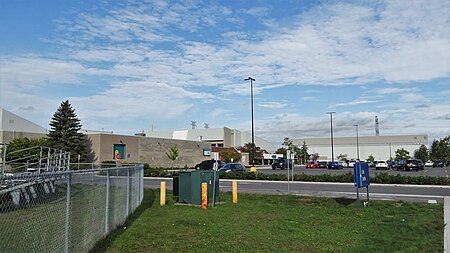Nepean ( nə-PEE-ən) is a former municipality and now geographic area of Ottawa, Ontario, Canada. Located west of Ottawa's inner core, it was an independent city until amalgamated with the Regional Municipality of Ottawa–Carleton in 2001 to become the new city of Ottawa. However, the name Nepean continues in common usage in reference to the area. The population of Nepean is about 186,593 people (2021 Census).
Although the neighbouring municipality of Kanata formed the entrepreneurial and high tech centre of the region, Nepean hosted noted industries such as Nortel Networks, JDS Uniphase and Gandalf Technologies. As with the rest of the National Capital Region, however, Nepean's economy was also heavily dependent on federal government employment. Most of Nepean's employed residents commute to downtown Ottawa or Kanata for work.Nepean's policies of operational and capital budgeting prudence contrasted with the budget philosophies of some other municipalities in the area. Nepean instituted a strict 'pay-as-you-go' budgeting scheme. The city entered amalgamation with a large surplus and a record of tax restraint. However, most big-ticket municipal infrastructure items (transit, garbage collection, sanitary sewers, water, arterial roads, social services) were the responsibility of the Regional Municipality of Ottawa-Carleton. It maintained its own library system from 1954 to amalgamation, its own police force from 1964 until it was regionalized in the 1990s; its own fire service and its own recreation programs. Hydro services were the responsibility of the Hydro-Electric Commission of the City of Nepean (commonly referred to as Nepean Hydro). Education in the City of Nepean was provided by the Carleton Board of Education (later amalgamated with the Ottawa Board of Education to form the Ottawa-Carleton District School Board).
Prior to amalgamation, Nepean's City Council spent many tax dollars aggressively campaigning against what they (and their allies) referred to as the "megacity" model. The central plank of the strategy was to promote a tri-city model, which would have seen the ten municipalities of the Ottawa region reduced to three: one in the west (comprising Nepean, Kanata and the western rural municipalities), one in the east (comprising Gloucester, Cumberland and the eastern rural municipalities) and one in the centre (comprising Ottawa, Vanier and Rockcliffe Park). These efforts were in vain, as the one-city model eventually prevailed. (The one-city model was recommended by Glen Shortliffe, who was appointed by the Government of Ontario to study the issue of municipal reform in Ottawa-Carleton.)




